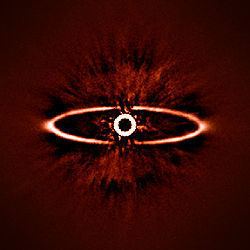Magnitude 5.8 Apparent magnitude (V) 5.8 | ||
 | ||
Similar HD 141569, Beta Pictoris, AU Microscopii, TW Hydrae, 2M1207 | ||
HR 4796 is a binary star system in the southern constellation of Centaurus. Parallax measurements put it at a distance of 237 light-years (73 parsecs) from the Earth. The two components of this system have an angular separation of 7.7 arcseconds, which, at their estimated distance, is equivalent to a projected separation of about 560 Astronomical Units (AU), or 560 times the separation of the Earth from the Sun. The star and its ring resemble an eye, and it is sometimes known by the nickname "Sauron's Eye".
This is a young system with an estimated age of about 8 million years. The primary member A has a stellar classification of A0 V, while its smaller companion B is a red dwarf with a classification of M2.5 V. The luminosity class of 'V' indicates that both stars belong to the main sequence and are generating energy through the thermonuclear fusion of hydrogen at their cores. The primary is emitting this energy from its outer envelope at an effective temperature of about 9,378 K, which gives it the white hue characteristic of A-type stars. It has a radius about 168% of the radius of the Sun and 218% of the Sun's mass. By comparison, the secondary has only 30% of a solar mass. The abundance of elements other than hydrogen or helium, what astronomers term the star's metallicity, is similar to the proportion in the Sun.
In 1991, the primary was found to have an excess of infrared emission, implying that it has a circumstellar debris disk. Observations using the Near-Infrared Multi-Object Spectrometer aboard the Hubble Space Telescope in 2007 indicated that the dust had a reddish spectrum similar to that of tholins. The disk was resolved with the Hubble Space Telescope in 2009, confirming that it exists. Based on these images, the disk has a radius of 75 AU and a width of less than 18.5 AU. It may have some asymmetries and the center appears to be slightly offset from the star. The dust in the disk is likely the result of collisions between larger particles. In 2011, observations of the ring offset by the Subaru Telescope implies that one or more planets would likely exist within gaps tugging at its dust grains. With a new image in 2014, the configuration and alignment of the dust ring and HR4796A has been nicknamed "Eye of Sauron".
The space velocity of HR 4796 in the Galactic coordinate system is [U, V, W] = [−8.5, −18.3, −3.6] km s−1. This trajectory and the location of the system suggests that it may be a member of the TW Hydrae association of stars that share a common origin. A low-mass member of this association, identified as 2MASS J12354893−3950245, may be a tertiary component of the HR 4796 system. It has a proper motion matching HR 4796, suggesting it is gravitationally bound to the other two stars, and is separated from the pair by a distance of about 13,500 AU.
